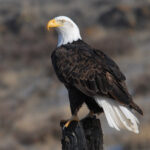Bald eagles are known for their impressive hunting skills and diverse dietary preferences. As apex predators, these majestic birds play a crucial role in the ecosystem, maintaining a delicate balance between various species. In this comprehensive blog post, we will delve into the intricacies of the bald eagle’s diet, exploring the different food sources they rely on and the factors that influence their feeding habits.
The Staple of Bald Eagle Diet: Fish
Bald eagles are primarily fish-eaters, with fish comprising 70 to 90 percent of their diet. These birds are adept at hunting a wide variety of fish species, including:
- Redhorse suckers
- Salmon
- Trout
- Carp
- Herring
- Catfish
The availability and abundance of these fish species in the bald eagle’s habitat largely determine their primary food source. For instance, at the ND-LEEF study site, redhorse suckers were observed to be the most common prey for the resident bald eagle pair.
Supplementing the Diet: Reptiles, Birds, and Mammals
While fish are the staple of the bald eagle’s diet, these opportunistic feeders are not limited to a single food source. Bald eagles have been known to supplement their diet with:
- Reptiles, such as snakes and turtles
- Birds, including waterfowl, gulls, and other smaller birds
- Mammals, such as rabbits, squirrels, and even young deer or carrion
The availability of these alternative food sources can vary depending on the bald eagle’s location and the time of year. For example, at the Smithsonian’s National Zoo, bald eagles have been observed consuming rats, chicken leg quarters, and quail in addition to their primary fish-based diet.
Factors Influencing Bald Eagle Diet
The bald eagle’s diet is influenced by several factors, including:
-
Prey Availability: The abundance and accessibility of different prey species in the bald eagle’s habitat play a significant role in determining their dietary preferences.
-
Energy Requirements: Bald eagles require a substantial amount of energy to sustain their active lifestyle, with an average daily intake of 0.6 to 1 pound of food. Their energy needs may fluctuate based on factors such as the time of year and their activity level.
-
Size and Age: The size and age of the bald eagle can also influence their dietary requirements. Smaller and younger eagles may require less food than their larger, older counterparts.
-
Lead Toxicity: Bald eagles can become ill if they consume prey that has been exposed to lead, such as deer carcasses with lead bullets. Lead poisoning is a significant concern for these birds, with studies showing that a significant percentage of bald eagles and golden eagles exhibit signs of chronic lead poisoning.
Ensuring a Healthy Bald Eagle Population
To maintain a thriving bald eagle population, it is crucial to ensure that these birds have access to an adequate supply of their preferred food sources, as well as suitable nesting sites close to their feeding grounds. Additionally, efforts to reduce lead exposure and minimize disturbances during nesting periods can greatly benefit the bald eagle’s overall well-being and survival.
By understanding the diverse dietary preferences and the factors that influence the bald eagle’s feeding habits, we can better appreciate the intricate role these majestic birds play in the delicate balance of their ecosystems.
References:
– Environmental Change Initiative, “Eagle Habitat & Diet – Environmental Change Initiative”, accessed on April 19, 2024, https://environmentalchange.nd.edu/resources/nd-leef/live-bald-eagle-cam/eagle-habitat-prey/
– American Eagle Foundation, “Bald Eagle Diet | American Eagle Foundation”, accessed on April 19, 2024, https://eagles.org/what-we-do/educate/learn-about-eagles/bald-eagle-diet/
– Smithsonian’s National Zoo and Conservation Biology Institute, “Bald eagle | Smithsonian’s National Zoo and Conservation Biology Institute”, accessed on April 19, 2024, https://nationalzoo.si.edu/animals/bald-eagle




